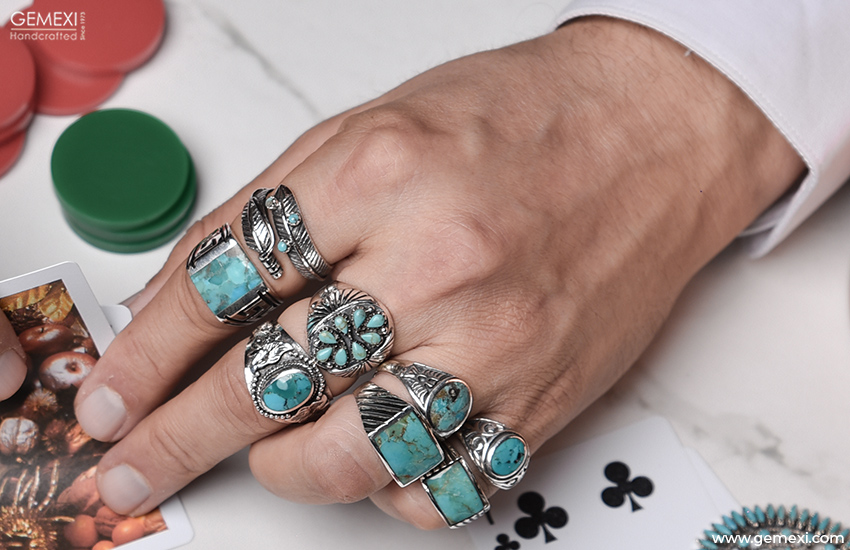Echoes of the Past: A Journey through Southwestern Jewelry
By Gemexi Team | Turquoise- Updated On Jun 15, 2023

In the vast and diverse landscape of jewelry-making, Southwestern jewelry stands as a testament to the power of regional influence, the integration of cultures, and a celebration of natural beauty. This form of jewelry, primarily associated with the American Southwest, boasts a rich history and a unique style that continues to captivate enthusiasts and collectors across the globe.
Historical Roots
The origins of Southwestern jewelry date back thousands of years, to the indigenous peoples of what is now the Southwestern United States, particularly the Navajo, Hopi, and Zuni tribes. Each tribe developed distinct styles, techniques, and motifs over centuries, incorporating materials available in their environment, like turquoise, silver, shell, and coral.
The Navajo, known for their skills in silversmithing, introduced the world to the intricate process of hand-hammered silver work in the mid-19th century, a technique they learned from Mexican silversmiths. They started crafting silver jewelry embellished with turquoise, a signature characteristic that became synonymous with Southwestern jewelry.
The Zuni tribe, on the other hand, became masters of inlay work and stone carving, producing exquisite pieces adorned with intricate patterns of turquoise, shell, and coral. Their knack for detailed work gave birth to Petit Point and Needle Point jewelry, styles defined by tiny, precisely cut stones.
Meanwhile, the Hopi tribe introduced overlay techniques, where two layers of silver are soldered together with cut-out designs on the upper layer, revealing the darkened silver beneath. This striking contrast in the jewelry is distinctly Hopi and is revered for its storytelling motifs.
The Navajo, known for their skills in silversmithing, introduced the world to the intricate process of hand-hammered silver work in the mid-19th century, a technique they learned from Mexican silversmiths. They started crafting silver jewelry embellished with turquoise, a signature characteristic that became synonymous with Southwestern jewelry.
The Zuni tribe, on the other hand, became masters of inlay work and stone carving, producing exquisite pieces adorned with intricate patterns of turquoise, shell, and coral. Their knack for detailed work gave birth to Petit Point and Needle Point jewelry, styles defined by tiny, precisely cut stones.
Meanwhile, the Hopi tribe introduced overlay techniques, where two layers of silver are soldered together with cut-out designs on the upper layer, revealing the darkened silver beneath. This striking contrast in the jewelry is distinctly Hopi and is revered for its storytelling motifs.
Cultural Cross-Pollination
Southwestern jewelry has also experienced significant cultural fusion, notably with Spanish and Mexican influences. The arrival of Spanish explorers and settlers in the 16th century introduced new tools and techniques to the indigenous artisans, like metal-smithing, leading to the evolution of designs and motifs.
Moreover, the iconic squash blossom necklace, despite its native name, is believed to have originated from Spanish pomegranate designs that came to the region during the Colonial period. It beautifully demonstrates how the melding of cultures contributed to the region's jewelry-making tradition.
Moreover, the iconic squash blossom necklace, despite its native name, is believed to have originated from Spanish pomegranate designs that came to the region during the Colonial period. It beautifully demonstrates how the melding of cultures contributed to the region's jewelry-making tradition.
Modern Southwestern Jewelry
In the present day, Southwestern jewelry is an amalgamation of past and present, tradition and innovation. Contemporary artists preserve the ancient techniques and spiritual elements but aren't afraid to infuse their work with modern design sensibilities.
Turquoise remains a favored gemstone, prized for its color variations and natural matrix patterns. However, artists also use a variety of other stones like opal, onyx, and even diamonds, broadening the palette and appeal of the jewelry.
Turquoise remains a favored gemstone, prized for its color variations and natural matrix patterns. However, artists also use a variety of other stones like opal, onyx, and even diamonds, broadening the palette and appeal of the jewelry.
The Symbolism
More than just visually striking, Southwestern jewelry is steeped in symbolism. Each piece tells a story or represents a belief. Animals, celestial bodies, and natural elements are common themes, each with their own spiritual significance. Turquoise, often referred to as the "stone of life," is believed to bring good fortune and protection.
In conclusion, Southwestern jewelry is a testament to the resilience and creativity of its makers. Each piece, whether vintage or contemporary, carries the echoes of its rich past. Its timeless appeal and deeply ingrained symbolism make it a truly unique segment of the global jewelry scene, merging beauty, history, and culture in every handcrafted piece.
In conclusion, Southwestern jewelry is a testament to the resilience and creativity of its makers. Each piece, whether vintage or contemporary, carries the echoes of its rich past. Its timeless appeal and deeply ingrained symbolism make it a truly unique segment of the global jewelry scene, merging beauty, history, and culture in every handcrafted piece.










0 Comments
Write Comments